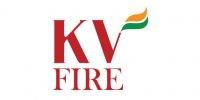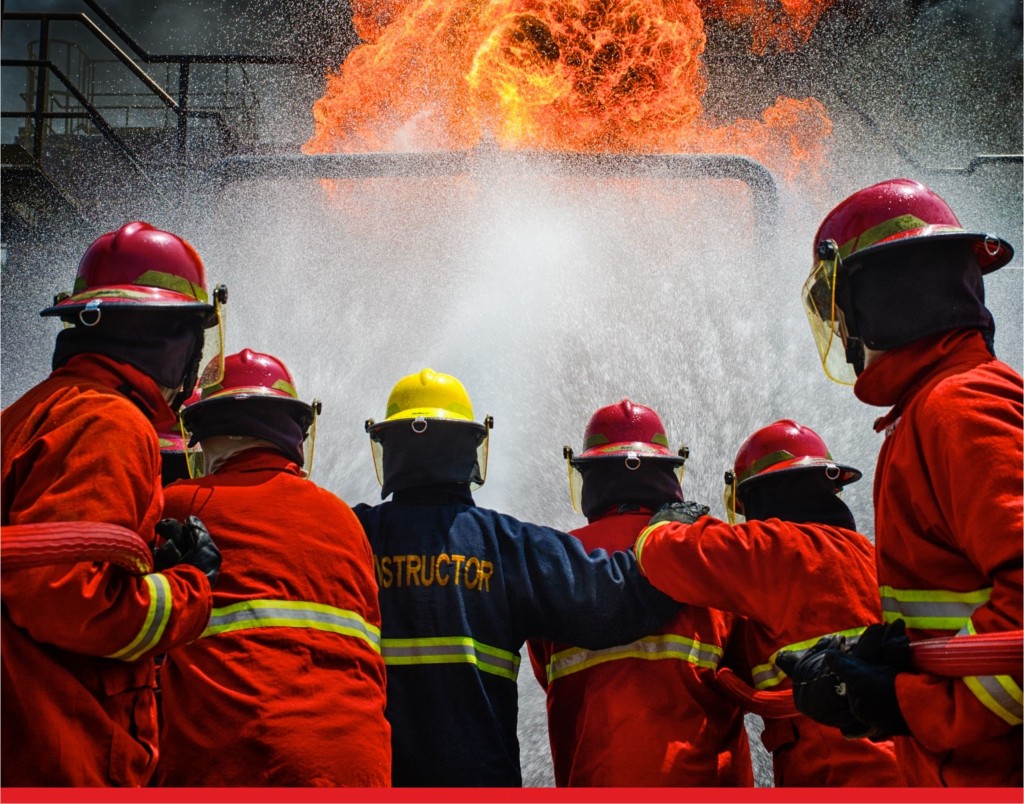 Businesses prepare for emergencies in various ways, from training emergency response teams to installing fixed fire suppression systems. But environmental accidents pose difficult challenges, attracting media attention, regulatory investigation, and enforcement actions. Media attention can quickly thrust unsuspecting companies into the spotlight, possibly tarnishing their public image and reputation. Regulatory investigations and enforcement actions can place managers on the defensive. Accidents can have a direct impact on the internal stakeholders, the company's most important asset-its employees. The public-the external stakeholders-is also affected and includes the residents near a facility and the company's shareholders. Exposure to potentially toxic substances heightens fear for employees and the general public.
Businesses prepare for emergencies in various ways, from training emergency response teams to installing fixed fire suppression systems. But environmental accidents pose difficult challenges, attracting media attention, regulatory investigation, and enforcement actions. Media attention can quickly thrust unsuspecting companies into the spotlight, possibly tarnishing their public image and reputation. Regulatory investigations and enforcement actions can place managers on the defensive. Accidents can have a direct impact on the internal stakeholders, the company's most important asset-its employees. The public-the external stakeholders-is also affected and includes the residents near a facility and the company's shareholders. Exposure to potentially toxic substances heightens fear for employees and the general public.
However, anticipating potential accidents and instituting prevention and mitigation strategies are essential for any emergency response program. Whether a company is a multibillion-dollar global organization or a local start-up, it is essential for it to anticipate potential emergencies. It is impossible to anticipate every type of emergency; that's not what response strategies are about. It's about understanding the tools a company has in its toolbox. This includes its internal capabilities and external resources, such as the company's on-site emergency response team, the available municipal emergency services, the contracted emergency response and cleanup services, and the available mutual aid from other industrial companies.
Unfortunately, many businesses believe that calling 911 will solve all their problems and provide a confined-space rescue team, a hazardous-materials team, and any other all-hazard mitigation team. That is until the Occupational Safety and Health Administration (OSHA) comes knocking at the door and asks, “Who is your response team? If it is a municipal entity, where is your agreement letter? Where are the training and site familiarity tour records?” Maybe you aren't as prepared as you thought and just saying you will call 911 isn't good enough. Failing to plan is planning to fail.
Industrial Emergency Response
Industrial facilities have significantly different response resource needs compared to municipal house fires. Most sites are collections of commercial buildings of various construction types. In certain areas, hazardous materials may be processed in bulk and laboratories may conduct thousands of unknown experiments for the first time, creating the potential for something unexpected to happen. These unique hazards can pose a significant risk to a municipal firefighter who may not be trained to properly handle them or is not briefed daily on changing conditions. Additionally, industry has the potential hazardous material and fire combination that is rarely encountered in the municipal response. There is a vast difference between the daily problems faced in municipal vs. industrial settings.
When is a fire call a fire? When is a fire call a hazmat incident? Answering those questions requires understanding the fire tetrahedron and how fire is an uninterrupted chemical reaction and how the addition of unknown chemicals creates a potentially catastrophic consequence. Many times, the results are fatalities or significant injuries, followed by a greater environmental impact from air dispersion and runoff. A municipal firefighter may not have the same level of understanding of these differences as an industrial firefighter or an emergency management expert.
Most importantly, municipal fire departments rely on industry's expertise and sometimes experience the “green smoke syndrome” when responding to an industrial facility incident in which all smoke will be some other color than the normal acrid black and brown. This occurs when firefighters are not familiar with a facility, its operations, and its internal fire protection capabilities. In some cases, they may choose to sit at the gate and wait until a plant representative arrives to provide crucial data. This is a nonoffensive response and the reality in many settings; it emphasizes the need for comprehensive preincident planning and constant interactions between plant personnel and municipal responders.
It is essential for industry to have good positive working relationships with the surrounding community as a whole and, most importantly, with local, county, and state responders. Industry and the community emergency services have common goals when responding to emergencies: life safety, incident stabilization/hazard mitigation, property conservation, and environmental considerations. Since time is money, industry banks on reducing or eliminating business interruption, protecting critical assets and documentation, and continuing operations in unaffected facility areas. It is essential that municipal emergency response agencies understand business priorities, which can only be accomplished through sound interactions. A key facet of this interaction is evaluating and having a thorough understanding of the municipal capabilities and what is in the fire department's and the industrial response's toolboxes.
What Tools Are Available?
In some cases, a gap exists in capabilities when industry evaluates its needs in light of the available municipal emergency services. For municipal emergency services, numerous factors may affect service delivery, including whether the location is rural or urban, whether personnel are available to respond at certain times of day, and the increased workload because of personnel shortages. Specialized training may include state-mandated training levels and response to unusual hazards and processes. Municipal tax authorities often scrutinize costs and eliminate or reduce services.
However, industry can effectively close or eliminate this gap by establishing in-plant emergency response teams for firefighting, hazmat, technical rescue, and a multitude of other needs and services. It must be stressed that the industrial response community can partner with the municipal response groups and reduce costs for both groups. A professionally trained response team offers an attack force at the complex to take action during those vital first minutes at an emergency.
Most, if not all, larger industries, particularly chemical, petrochemical, refining, pharmaceutical, and similar facilities, have some type of on-site emergency response team. These teams vary. They may include incipient fire brigades; spill/hazardous materials teams; or full structural fire departments, which can be full-time paid, combination, or all-volunteer entities. Many industries also have confined space, swiftwater, trench; or high-angle rescue teams and emergency medical service (EMS) capabilities. Internal teams can improve response effectiveness through their inherent knowledge of facility operations, and they can significantly reduce business-interruption costs and, most importantly, allow everyone to go home.
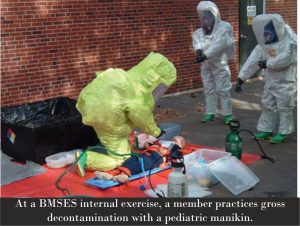 In a pharmaceutical research setting, when a hazmat spill occurs, an internal response team responds and mitigates the situation quickly with its toolbox (equipped with hazmat technicians, chemists, spill response equipment, decontamination capabilities, and more), often permitting researchers to get back in the laboratory hours sooner. If relying solely on municipal responders, the potential delays could include the time required for the municipal entities to respond, understand the situation, mobilize equipment, mitigate the incident, and return the area back to the building owner. Such extended operations could delay researchers in getting back to the laboratory bench or chemical fume hood, potentially extending the time for a new drug to reach the marketplace. Potentially, this could result in millions of dollars of lost revenue. Internal teams also reduce the burden on municipal responders to respond to an increased number of service calls from the industry, which reduces not only the impact on a shrinking pool of available responders but also service costs for the municipalities.
In a pharmaceutical research setting, when a hazmat spill occurs, an internal response team responds and mitigates the situation quickly with its toolbox (equipped with hazmat technicians, chemists, spill response equipment, decontamination capabilities, and more), often permitting researchers to get back in the laboratory hours sooner. If relying solely on municipal responders, the potential delays could include the time required for the municipal entities to respond, understand the situation, mobilize equipment, mitigate the incident, and return the area back to the building owner. Such extended operations could delay researchers in getting back to the laboratory bench or chemical fume hood, potentially extending the time for a new drug to reach the marketplace. Potentially, this could result in millions of dollars of lost revenue. Internal teams also reduce the burden on municipal responders to respond to an increased number of service calls from the industry, which reduces not only the impact on a shrinking pool of available responders but also service costs for the municipalities.
Bristol-Myers Squibb (BMS) is not alone in providing emergency response services for its facilities as well as the many communities in which its facilities are located. BMS is a global biopharmaceutical company with multiple varied-use facilities in New Jersey, ranging from offices to research laboratories to clinical supply manufacturing.
BMS first established a structural fire brigade at its New Brunswick facility in the 1940s, operating one pumper (photo 1). Over the years, the program at the New Brunswick facility has continued expanding its on-site capabilities, adding an ambulance to the fleet in 1983, and a foam pumper with a 1,000-gallon-per-minute (gpm) pump, carrying 300 gallons of aqueous film-forming foam (AFFF) in 1987. With company expansion, the response team expanded to the Lawrenceville facility in 1986 and to the Hopewell facility in 1997. At the same time, the company added a 2,000-gpm foam pumper with a 65-foot waterway carrying 300 gallons of AFFF, three hazardous materials/technical rescues, three new ambulances, a mass decontamination unit, and two command vehicles. It also built three firehouses.
Today, BMS Emergency Services (BMSES) teams are comprised of a cross-section of site personnel involved in all operations within a facility including office, maintenance/operations, laboratory, and management employees. The response team is charged with implementing site emergency response plans; then classification, identification, and verification of known and unknown materials using field survey instruments and equipment; the use of specialized chemical personal protective equipment; understanding hazard- and risk-assessment techniques; performing advanced control, containment, and confinement operations; decontamination procedures; and chemical toxicological data (photo 3).
The response teams are supported by research chemists, who assist in dealing with advanced chemical reactions, and health physics technicians, who are experts in radiological emergencies. An on-site, full-service medical staff provides on-scene medical surveillance at all incidents and can provide advanced life support if needed. The medical staff is comprised of doctors and nurses who work in Employee Health Services and are involved with employee surveillance and other occupational medical needs every day.
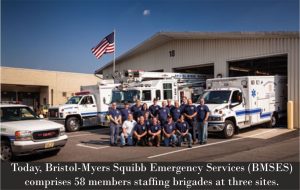 Joint Industrial/Municipal Training
Joint Industrial/Municipal Training
BMS has developed relationships with the municipal responders who assist with protecting its facilities and future. The BMS response teams work closely with their first-due municipal responders. Fire company and response team members regularly conduct joint training exercises on the Lawrenceville and the Hopewell Junction campuses, in the community, and at the local fire academies. Such exercises provide the basis for an effective relationship and allow community responders to see firsthand how the BMS facilities operate and to understand each other's equipment and training capabilities (photos 4-6).
It is too late to introduce the local fire department to your site when an emergency incident is in progress. Incidents go more smoothly when the two entities are familiar with each other, have trained together, and have a mutual respect for each other. This approach also overcomes many of those “old school” misconceptions-i.e., that industry has in its fire brigades only “wannabe” firefighters who do not enter burning buildings and medical responders who are trained only to the first-aid level. Most industrial fire brigade members are chemical or mechanical professionals who take on the additional role of emergency responder with training that is equal or superior to that of external agencies.
In many cases, fire brigade members are volunteer firefighters and EMS providers with their local fire companies or EMS units and may also serve as line officers. Additionally, several members of the BMSES are instructors at county fire academies because of their specialized knowledge and are members of external urban search and rescue teams. These are valuable opportunities for the company's responders to share their time, talent, and treasure helping the local communities where they live and work.
On-site emergency industrial response teams are fully capable, willing, and able to assist external stakeholders including various municipal emergency response partners. Industry has a multitude of resources to offer from personnel and equipment to OSHA-required and site-specific hazard training. Many industrial response teams have entered into formal mutual-aid agreements at the local, county, and state levels to provide firefighting, hazardous materials response, and technical rescue services. Although the community benefits from these services, the company also enhances its image as a good community-minded neighbor.
Public/Private Partnership Agreements
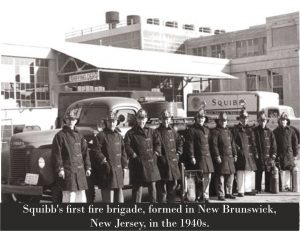 BMS has entered into several mutual-aid agreements with the municipalities surrounding its New Jersey campuses. These agreements include structural firefighting, hazmat response, mass decontamination, and technical rescue services. Through these agreements, the company provides one of the few National Incident Management System Type III Basic Life Support ambulances in New Jersey staffed by two emergency medical technicians with hazmat technician capability.
BMS has entered into several mutual-aid agreements with the municipalities surrounding its New Jersey campuses. These agreements include structural firefighting, hazmat response, mass decontamination, and technical rescue services. Through these agreements, the company provides one of the few National Incident Management System Type III Basic Life Support ambulances in New Jersey staffed by two emergency medical technicians with hazmat technician capability.
BMS has participated with New Jersey state task forces and strike teams in response to the tragic events of 9/11 and Hurricanes Irene and Sandy, the Special Olympics state and national games, and many other local calls for emergency assistance. BMS is a founding member of the Mutual Aid Cooperative State Industrial Chiefs, providing through mutual aid two foam pumpers and other emergency equipment and supplies to other industrial facilities throughout New Jersey in the event of a significant complex incident.




































